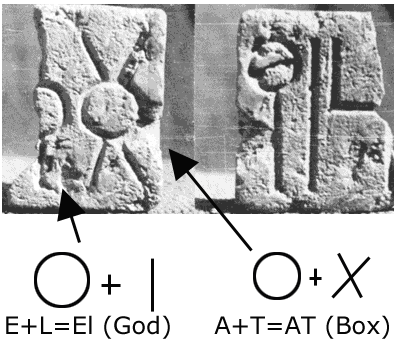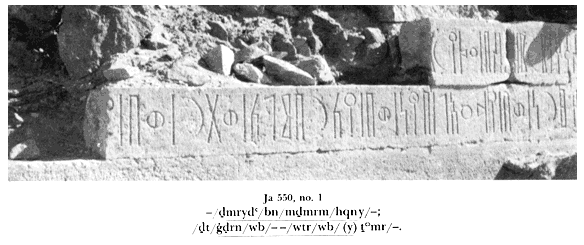Above is the first of many illustrations of the exterior wall of the Temple of Sheba, taken from W. F. Jamme's book, Sabaean Inscriptions from Mahram Bilqis (Marib), (1962). Most of the artifacts were photographed by Jamme himself and were gathered under restrictive circumstances owing to the territorial disputes that still continue in Yemen. Jamme's methodology of transliteration is of interest to us because we have translated a small portion of these artifacts with an entirely different algorithm. We will attempt to show the difference in these two approaches. We have determined the sound values for an assortment of letters based in the work of Dr. James Harris (BYU), who successfully translated numerous scripts in the Negev desert. Earlier forms of this script have also been found as far back as 8,000 years ago, which demonstrate the consistency of grammar and dialect. This discovery was not made when Jamme attempted his translations in 1962. He therefore relied on the Ethiopian sound values. Some sound values required for Arabic dialects are different from the proto-Semitic language that we believe was used when the older artifacts were made. Various letters in the relatively newer Ethiopian alphabet, which were Jamme's only resource, have been re-assigned to Arabic phonetics. But there are other errors as well. The early language used characters called "ligatures" (a group of letters which are graphically combined to represent a more compact and unified shape). In the artifacts that we reviewed from Bilqis, we noted ligatures for such words as "EL" (the Lord), "BN" (the Son), "BL" (life, love), "TseL" (protection), while these ligatures have been assigned the status of single letter sounds in the Ethiopian version.
 The artifacts pictured above attest to the use of ligatures in the older language. This "anomaly" on the left is the ligature for AT "chamber, cabinet, box, cell..." as in the Ark of the Covenant. Note that it appears to be immediately followed (to its left) by a ligature for EL "the Lord." In many instances the ligatures were used when the referenced word was repeated within the text or if it previously made reference to a person. Jamme's methodology did not recognize the lamed as a vertical line and instead considered this line to indicate word or phrase breaks, as we would use punctuation. According to Jamme's tables, the gimmel of the older language is read as a lamed. Jamme also interprets the ligatures for "EL" to have the sound value of qof, and attributes an "S" sound to the ligature for "BN" and "BL." It is then not too surprising that Jamme's results consist largely of complex personal names and alleged genealogies. He also reads the script from left-to-right, even when the "fonts" are reversed. It was the practice to alternate the direction in multi-lined texts so that the reader could scan the text in a zig-zag pattern. Confusion was avoided by writing the letters backwards on alternate lines. Jamme seems to have ignored this phenomenon. One can see the "Mem" and "Resh" to quickly determine the correct flow. By reading from left-to-right, Jamme was fortunate at least half of the time, but without using the correct sound values his translations are mundane at best. Our methodology reads the script from right-to-left and alternates as the letters are mirrored. This provides a relatively smooth and meaningful translation without constant mention of personal names or tribes. The vertical line in our interpretation is a lamed and we recognize the word or phrase breaks as being marked by the vav, which resembles a dissected circle or can be two adjacent circles. This translates as "but, and, also..." and makes for some long run-on phrases that would enrage a modern editor. The writers were careful to repeat their phrases and to use multiple ligatures to assist in the deciphering of these strings of letters. Since most words are devoid of vowels (except if the vowel falls outside of the last consonant) there are typically two letters to a word. Where there could be some ambiguity with similar adjacent letters, alternate forms of the letters will be used to denote word breaks. An example would be "the chamber underneath" AT-TT. This would be written similar to AtTT to allow the reader to see that the break is between the two forms of the letter. Otherwise this string of letters could possibly be interpreted as "the signal" ATT-T. We have identified alternate forms for bet, chet, dalet, and tav in the Bilqis alphabet. The older examples of this script also employ alternates for peh, mem, nun, tsadeh and zayin. In addition, the script in North America and the Negev has used rotation of letters and repetition of the final consonant to to indicate phrase breaks. Undoubtedly some of the material at Bilqis was produced in the last two millennia and utilize the Ethiopian variant. This older language was buried, literally, and disappeared for almost 800 years, before emerging in Ethiopia with a new dialect and quickly spread back to Yemen. Our translations seem to state that this dormant interval was the result of events surrounding the only son of Queen Saba (Queen Sheba), Menelik, whose mother had her former palace and temple buried to prevent its destruction and pillage by invading nations (see transliteration below). What has been translated thus far? Using the algorithm that has been successful in translating numerous examples of this script from around the world, we have obtained the following information, quoted here from a letter sent to His Eminence, Abdulla Salleh, President of The Republic of Yemem. Menelek (spelled MNLCC), the only son of Queen Saba (Queen Sheba) and Solomon, was depressed when he learned that his father's kingdom had been overcome and the Temple in Jerusalem was sacked. His grief was deep ("The happiness of the Son was poisoned...") and this worried his mother. Shortly after this invasion of Jerusalem, Menelik received word that the Ark of the Covenant (the "cell of the Lord" AT-EL), formerly housed in Solomon's Temple, was relocated to what is now Yemen and was in the protection of Menelik. The text refers to an "oath" that was taken by Menelik to protect the Ark, perhaps agreed upon when he visited Solomon several years earlier. Menelik also received a warning from Nathan, Menelik's half-brother, that the Ark could be harmful to his health and that it had caused vision problems and "trembling" (seizures?)when Nathan had attempted to interact with it. Menelik, however, had none of these adverse reactions and eagerly interacted with this object, constructing a special chamber underground in which he stored the Ark and conversed through it with the Lord.Additional translations are beginning to fill in the gaps of this remarkable story and we will present these as they are translated.
.Gary Vey |
